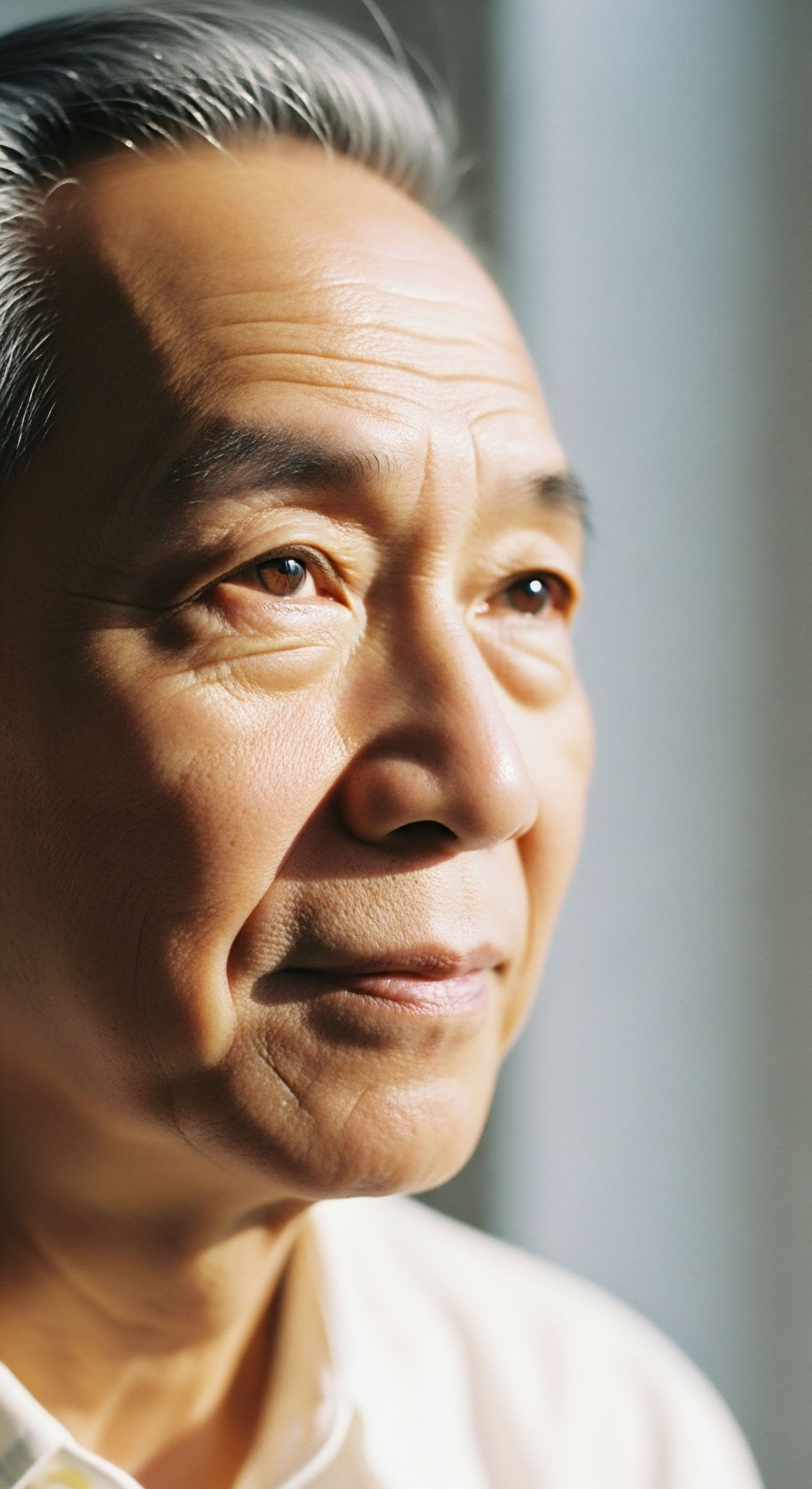

Fundamentals
You feel it before you can name it. A persistent drag on your energy, a fog that clouds your thoughts, a frustrating disconnect from the vitality you once took for granted. You may have even pursued clinical evaluation, receiving lab results that seem to sit in a gray area, leaving you with more questions than answers.
This experience, this subjective sense that your internal machinery is miscalibrated, is the essential starting point of a meaningful health investigation. Your lived reality is the most important dataset you possess. The process of hormonal optimization begins with validating that experience and then methodically connecting it to the intricate biological systems that govern your well-being. The goal is to understand the language of your own body, translating feelings into physiology and back again.
At the center of this conversation is the endocrine system, a sophisticated communication network that uses hormones as its chemical messengers. Testosterone is one of its most critical signals, responsible for a vast array of functions from maintaining muscle mass and bone density to regulating mood, cognitive function, and libido.
When this signal weakens or becomes erratic, the entire system can lose its rhythm. Therefore, therapeutic intervention is a process of restoring that natural, physiological rhythm. It involves supplying the necessary hormonal signal in a manner that the body can recognize and utilize effectively. The method of delivery is a foundational component of this restoration, as it dictates the pattern and stability of the hormonal message being sent to your cells.

The Concept of Hormonal Rhythm
Your body operates on cycles. The daily rise and fall of cortisol, the monthly cadence of female reproductive hormones, and the steady pulse of thyroid hormone all create a dynamic internal environment. Healthy testosterone levels in a male, for instance, naturally peak in the morning and decline throughout the day.
This fluctuation is information. When we introduce exogenous testosterone, the objective is to mimic a healthy, stable physiological state. Different delivery methods create different hormonal release patterns, each with its own unique “pharmacokinetic” profile ∞ the way the substance is absorbed, distributed, metabolized, and eliminated by the body. Understanding these profiles is the first step in tailoring a protocol to your individual biology.
The selection of a testosterone delivery method is the first and most critical step in shaping the hormonal environment to match individual physiological needs.
Imagine your body’s hormonal state as a reservoir of water. The goal is to keep the water level consistently within a healthy range. Some delivery methods are like opening a faucet for a short, intense period, causing the level to rise rapidly and then fall.
Others are like a slow, continuous drip, maintaining a much more constant level. Neither is inherently superior; their appropriateness depends entirely on the individual’s unique physiology, metabolism, and the specific therapeutic goals being pursued.

An Overview of Delivery Systems
The primary methods for delivering testosterone each create a distinct pattern of release, directly influencing how you feel and respond to therapy. Thinking about them in terms of their delivery cadence can provide initial clarity.
- Intramuscular or Subcutaneous Injections ∞ This method involves injecting a testosterone ester, such as Testosterone Cypionate or Enanthate, into muscle or subcutaneous fat. The ester is a chemical modification that allows the hormone to be released slowly over time. The frequency of these injections ∞ whether weekly, twice-weekly, or on another schedule ∞ is a key variable that is adjusted to create stable blood levels. More frequent injections of smaller doses generally lead to more stable levels, minimizing peaks and troughs.
- Transdermal Applications ∞ Gels and creams are applied to the skin daily. This method provides a steady, continuous absorption of testosterone throughout the day, closely mimicking the body’s natural diurnal rhythm. It offers convenience and stable levels, though absorption rates can vary between individuals and require careful application to avoid transference to others.
- Subdermal Pellets ∞ These are small, crystalline pellets of testosterone that are implanted under the skin in a minor office procedure. They are designed to dissolve slowly, releasing a consistent dose of testosterone over a period of three to six months. This method is highly convenient for those who prefer to avoid regular injections or daily applications, offering a very stable, long-term hormonal foundation.
The choice between these methods is a clinical decision made by integrating your personal preferences, lifestyle, and, most importantly, your unique biological markers. The journey to optimization is one of partnership between you and your clinician, using data and your subjective experience to find the delivery system that best restores your body’s intended hormonal symphony.


Intermediate
To truly tailor a testosterone delivery method, we must move beyond basic descriptions and into the clinical science of pharmacokinetics. This field of study quantifies how a substance moves through the body, providing a map of its journey from administration to elimination.
For hormonal optimization, the key pharmacokinetic parameters are Cmax (the maximum serum concentration), Tmax (the time it takes to reach Cmax), and the elimination half-life (the time required for the concentration to reduce by half). These metrics allow a clinician to predict how a specific dose and delivery method will behave in the body, forming the basis for creating a stable and effective therapeutic protocol.
Intramuscular injections of testosterone esters like Cypionate or Enanthate, for example, are designed for a timed release. The ester tail attached to the testosterone molecule must be cleaved off by enzymes in the body before the hormone becomes active. This process creates a predictable release curve.
A single, large injection every two weeks will produce a high Cmax shortly after the injection, followed by a gradual decline that can sometimes fall below the optimal range before the next dose. This “peak and trough” effect can lead to fluctuations in mood, energy, and libido.
To mitigate this, modern protocols often utilize more frequent injections of smaller doses (e.g. weekly or twice-weekly), which dampens the peaks and raises the troughs, creating a much more stable hormonal environment. This approach is a direct application of pharmacokinetic principles to improve patient outcomes.

Comparative Pharmacokinetics of Delivery Methods
Each delivery system possesses a unique pharmacokinetic signature. The clinical art of hormonal optimization lies in selecting the signature that best aligns with the patient’s metabolic and physiological landscape. A direct comparison illuminates the distinct advantages and considerations of each approach.
| Delivery Method | Typical Dosing Frequency | Pharmacokinetic Profile | Key Clinical Considerations |
|---|---|---|---|
| Intramuscular Injections (e.g. Testosterone Cypionate) | Weekly or Twice-Weekly | Creates predictable peaks and troughs. More frequent dosing leads to greater stability and levels in the mid-to-high normal range. | Requires comfort with self-injection. Cost-effective. Allows for precise dose adjustments. Potential for fluctuations if dosing is infrequent. |
| Subcutaneous Injections | Twice-Weekly or Every Other Day | Slower absorption from fat tissue compared to muscle, leading to a blunted Cmax and more stable serum levels. | Often preferred for its comfort over intramuscular injections. Allows for very stable levels with micro-dosing strategies. Excellent for precise control. |
| Transdermal Gels/Creams | Daily | Provides a consistent, steady-state concentration after a few days of use, mimicking the natural diurnal rhythm. | High patient convenience. Risk of transference to partners or children. Absorption can be variable based on skin type and application site. |
| Subdermal Pellets | Every 3-6 Months | Delivers very stable, consistent hormone levels for an extended period after an initial peak post-insertion. | “Set it and forget it” convenience. Requires a minor in-office procedure for insertion. Dose adjustments can only be made at the time of re-insertion. |

How Are Protocols for Men and Women Different?
The principles of hormonal balance apply to both sexes, but the clinical applications and target ranges are distinct. The goal in men is to restore youthful, physiological testosterone levels, while in women, it is often to reintroduce a small, beneficial amount of testosterone to address specific symptoms like low libido, fatigue, and cognitive fog, particularly during perimenopause and post-menopause.

Standard Male Optimization Protocol
A well-structured protocol for a male patient often involves more than just testosterone. It is a multi-faceted approach designed to support the entire endocrine system. A common, effective protocol includes:
- Testosterone Cypionate ∞ Typically administered as a weekly intramuscular or twice-weekly subcutaneous injection. The dose is titrated based on follow-up blood work and patient symptoms, with the goal of achieving total testosterone levels in the mid-to-upper end of the normal range.
- Gonadorelin ∞ This is a peptide that mimics Gonadotropin-Releasing Hormone (GnRH). When exogenous testosterone is introduced, the brain’s natural production of GnRH decreases, which in turn signals the testes to stop producing testosterone and can lead to testicular atrophy. Gonadorelin is administered via subcutaneous injection (e.g. twice-weekly) to stimulate the pituitary gland, preserving testicular function and size, which many men find beneficial for overall well-being.
- Anastrozole ∞ An Aromatase Inhibitor (AI). The enzyme aromatase converts a portion of testosterone into estradiol (an estrogen). While some estrogen is essential for male health (supporting bone density, joint health, and libido), excessive levels can lead to side effects like water retention and gynecomastia. Anastrozole is used judiciously, typically as a low-dose oral tablet, to manage estradiol levels and keep them within an optimal range, preventing side effects without suppressing this vital hormone.
A comprehensive male protocol addresses the entire hormonal axis, using ancillary medications to maintain systemic balance and mitigate potential side effects.

Female Hormonal Support Protocols
For women, hormonal therapy is about restoring balance across multiple hormones. Testosterone is a key part of this, but it is used in much smaller doses and often in conjunction with other support.
Protocols for women are highly individualized based on their menopausal status. Subcutaneous injections of Testosterone Cypionate at low doses (e.g. 10-20 units weekly) can effectively alleviate symptoms without causing masculinizing side effects. This is often paired with Progesterone, which provides balance and has protective benefits. For some women, pellet therapy offers a convenient long-term solution, providing a steady state of testosterone that supports energy, mood, and sexual health for months at a time.


Academic
The ultimate refinement of testosterone therapy transcends generalized protocols and enters the realm of true biochemical individuality. At this level of clinical sophistication, adjusting a delivery method is a strategic decision informed by an understanding of how pharmacokinetics intersect with an individual’s unique genetic predispositions.
Two of the most impactful variables in this equation are the genetics governing Sex Hormone-Binding Globulin (SHBG) and the sensitivity of the Androgen Receptor (AR). These factors fundamentally dictate how a person will experience and respond to a given serum level of testosterone, making them critical considerations for advanced protocol design.
SHBG is a glycoprotein produced primarily in the liver that binds with high affinity to sex hormones, including testosterone. It acts as the primary transport and reservoir for testosterone in the bloodstream. The portion of testosterone that is not bound to SHBG or albumin (loosely bound) is considered “free” or “bioavailable” and is able to exert its effects on target tissues.
Genetic variants in the SHBG gene can lead to significant inter-individual differences in circulating SHBG levels. This has profound implications for therapy. A patient with genetically high SHBG will bind a larger percentage of administered testosterone, resulting in lower free testosterone levels. Conversely, a patient with genetically low SHBG will have a higher proportion of free testosterone, making them more sensitive to a given dose and potentially more prone to side effects from elevated levels of active hormone.

The Clinical Impact of SHBG on Protocol Design
A clinician must account for SHBG levels when selecting both the dose and the delivery method of testosterone. The patient’s SHBG level acts as a buffer, influencing the stability and bioavailability of the hormone. This understanding allows for proactive protocol adjustments.
| SHBG Level | Biochemical State | Clinical Implications | Strategic Protocol Adjustments |
|---|---|---|---|
| Low SHBG | Higher percentage of free, bioavailable testosterone. Faster clearance of testosterone from the system. | Patient may be more sensitive to standard doses and experience more pronounced peaks and troughs. Higher potential for aromatization to estradiol. | Utilize more frequent injections of smaller doses (e.g. subcutaneous injections every other day) to maintain stability. Transdermal gels can also be effective. Lower total testosterone dose may be required. |
| High SHBG | Lower percentage of free, bioavailable testosterone. Slower clearance of testosterone from the system. | Patient may feel symptomatic even with total testosterone levels in the normal range. A higher total testosterone level may be needed to achieve an optimal free testosterone level. | May tolerate less frequent injections (e.g. weekly intramuscular). Higher doses may be necessary to saturate SHBG and raise free T. Pellets can be a good option for sustained high-normal levels. |

What Is the Role of Androgen Receptor Sensitivity?
The final destination for testosterone is the Androgen Receptor (AR), a protein within cells that, when activated by testosterone or its more potent metabolite DHT, initiates a cascade of genetic transcription responsible for androgenic effects. The sensitivity of this receptor is not uniform across the population.
It is modulated by a polymorphic CAG repeat sequence in the AR gene. Individuals with a shorter CAG repeat length tend to have more sensitive androgen receptors, meaning they can elicit a strong physiological response even at moderate testosterone levels. Those with a longer CAG repeat length have less sensitive receptors and may require higher free testosterone levels to achieve the same clinical effect.
True personalization of therapy requires looking beyond serum levels to understand the genetic factors that govern hormonal transport and cellular response.
This genetic variability explains why two men with identical free testosterone levels can have vastly different outcomes. One may experience significant improvements in muscle mass, libido, and well-being, while the other reports minimal benefits. This is the essence of pharmacogenetics in endocrinology.
An individual with high SHBG and long CAG repeats (insensitive receptors) represents a clinical challenge, often requiring higher doses and a carefully managed protocol to achieve symptomatic relief. In contrast, a patient with low SHBG and short CAG repeats (sensitive receptors) must be managed with great care, often with micro-dosing strategies, to avoid an over-response and potential side effects.

A Systems Biology Approach to Optimization
The most advanced clinical perspective views testosterone optimization through a systems biology lens. The patient’s response is an emergent property of a complex, interconnected system. It is the dynamic interplay between:
- Pharmacokinetics ∞ The release profile of the chosen delivery method (e.g. injection, gel, pellet).
- Binding Globulins ∞ The patient’s genetically determined SHBG level, which modulates the amount of free, active hormone.
- Receptor Sensitivity ∞ The genetically determined sensitivity of the Androgen Receptor (CAG repeat length), which dictates the magnitude of the cellular response.
- Metabolic Pathways ∞ The activity of enzymes like aromatase (converting testosterone to estrogen) and 5-alpha reductase (converting testosterone to DHT), which can also have genetic variability.
By considering all these factors, a clinician can move from a one-size-fits-all approach to a truly personalized protocol. This involves selecting a delivery method whose pharmacokinetic curve is best suited to the patient’s SHBG status and then titrating the dose to a level that provides optimal saturation of their unique androgen receptors. This is the pinnacle of personalized endocrine medicine, where science is applied with precision to restore the unique biological harmony of the individual.

References
- Bhasin, Shalender, et al. “Testosterone Therapy in Men with Hypogonadism ∞ An Endocrine Society Clinical Practice Guideline.” The Journal of Clinical Endocrinology & Metabolism, vol. 103, no. 5, 2018, pp. 1715 ∞ 1744.
- Zitzmann, Michael. “The Role of the CAG Repeat Androgen Receptor Polymorphism in Andrology.” Frontiers of Hormone Research, vol. 37, 2009, pp. 52-61.
- Oskui, Reza, et al. “The Heart of the Matter ∞ The Relationship Between Testosterone and Heart Disease.” Current Sexual Health Reports, vol. 6, no. 2, 2014, pp. 122-130.
- Ohl, D. A. et al. “Coadministration of anastrozole sustains therapeutic testosterone levels in hypogonadal men undergoing testosterone pellet insertion.” The journal of sexual medicine, vol. 11, no. 1, 2014, pp. 254-61.
- Meikle, A. W. et al. “Pharmacokinetics, efficacy, and safety of a permeation-enhanced testosterone transdermal system in comparison with bi-weekly injections of testosterone enanthate for the treatment of hypogonadal men.” The Journal of Clinical Endocrinology & Metabolism, vol. 82, no. 10, 1997, pp. 3299-3305.
- Jockenhovel, F. et al. “Pharmacokinetics and metabolism of a new testosterone transdermal delivery system, TDS-testosterone in healthy males.” British journal of clinical pharmacology, vol. 51, no. 1, 2001, pp. 25-32.
- Jin, Guang-Hee, et al. “Genetic variants in the SHBG locus are associated with a substantial variation in testosterone concentrations.” PLoS genetics, vol. 7, no. 6, 2011, e1002129.
- Tartaglia, Nicole. “Effects of Testosterone and Genetic Factors on Psychological and Motor Function.” Grantome, 2011.
- Pendergraft, III, William F. et al. “Pharmacokinetic comparison of three delivery systems for subcutaneous testosterone administration in female mice.” General and Comparative Endocrinology, vol. 326, 2022, 114090.
- Kanakis, G. A. & Goulis, D. G. “Pharmacology of testosterone replacement therapy preparations.” Hormones (Athens, Greece), vol. 16, no. 2, 2017, pp. 141-152.

Reflection

Charting Your Own Biology
You have now journeyed through the foundational principles, clinical protocols, and deep science of testosterone optimization. This knowledge serves a singular purpose ∞ to provide you with a more detailed map of your own internal landscape. The language of pharmacokinetics, the role of binding globulins, the concept of receptor sensitivity ∞ these are the landmarks and terrain features of your unique biology. Understanding them transforms you from a passenger into an active navigator of your health journey.
Consider the patterns of your own experience. Do you feel best with steady, consistent energy, or are you accustomed to a different rhythm? How does your body respond to change? The answers to these questions are valuable data points. They are the subjective experiences that, when paired with objective clinical data, illuminate the path forward. This information is the beginning of a new kind of conversation with yourself and with the clinical partners who can guide you.
The ultimate goal is a state of congruent well-being, where your subjective feelings of vitality are supported and explained by a balanced and stable physiological reality. The path to that state is yours alone, but it is a path that you can now walk with greater clarity, confidence, and a profound appreciation for the intricate, intelligent system that is your body.



